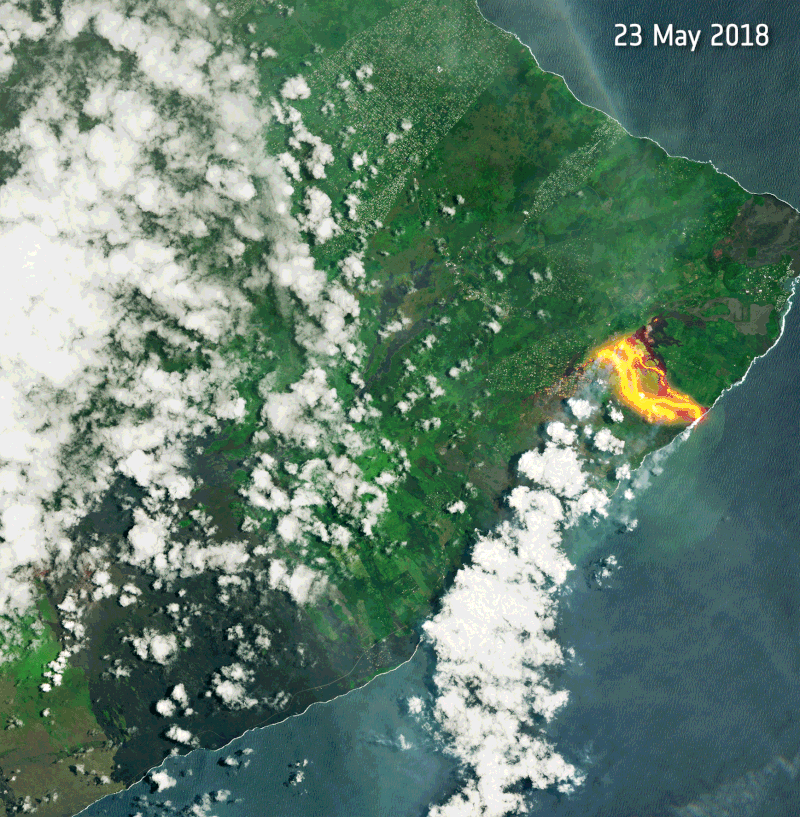
The European Space Agency (ESA) released this animated gif on June 8, 2018, showing the ongoing eruption of Kilauea Volcano in Hawaii. ESA said:
It is estimated that around 600 homes have been destroyed in one of the volcano’s most destructive eruptions in modern times. According to Hawaii County Mayor, Harry Kim, Kilauea has never destroyed so many homes in such a short time. It is one of five volcanoes on the Big Island and is one of the world’s most active volcanoes.
Hawaii's largest freshwater lake just met #Kilauea — and got vaporized https://t.co/V8eQfJeo54 pic.twitter.com/p8Le4tgkWE
— MotherNatureNetwork (@MotherNatureNet) June 8, 2018
Drone captures lava flow from Kilauea to the sea; total so far could cover Manhattan more than 6 feet deep https://t.co/4VXwZPDGsw pic.twitter.com/yhw3IfhUE3
— WHNT (@whnt) June 8, 2018
WATCH: Take a look at the coastline of Hawaii's Big Island — as the eruption of the Kilauea volcano continues.
The eruption has wiped out at least 600 homes on the Big Island. pic.twitter.com/Ims2MwW2Yj— CBSDenver (@CBSDenver) June 8, 2018
The Hawaiian Volcano Observatory issued this status report on Friday, June 8, 2018:
Vigorous eruption of lava continues from the lower East Rift Zone fissure system in the area of Leilani Estates.
Overnight, lava fountaining at Fissure 8 continue to reach heights of about 220 feet [67 meters] … There is no lava activity from the other fissures but Fissure 24 is incandescent and Fissures 24, 9, and 10 are fuming heavily.
Pele’s hair and other lightweight volcanic glass from high fountaining of Fissure 8 are falling downwind of the fissure and accumulating on the ground within Leilani Estates. High winds may waft lighter particles to greater distances. Residents are urged to minimize exposure to these volcanic particles, which can cause skin and eye irritation similar to volcanic ash.
Click here for the most recent map of lava flows.
Hawaiian Volcano Observatory field crews are on site tracking the fountains, lava flows, and spattering from Fissure 8 as conditions allow and are reporting information to Hawaii County Civil Defense. Observations are also collected on a daily basis from cracks in the area of Highway 130; no changes in temperature, crack width, or gas emissions have been noted.
Volcanic gas emissions remain very high from Fissure 8 eruptions. For the next few days, easterly wind conditions may bring vog not only to the south and west sides of the Island of Hawaii, but also upslope to the island’s interior.
The ocean entry is a hazardous area. Venturing too close to an ocean entry on land or the ocean exposes you to flying debris from sudden explosive interaction between lava and water. Also, the lava delta is unstable because it is built on unconsolidated lava fragments and sand. This loose material can easily be eroded away by surf, causing the new land to become unsupported and slide into the sea. Additionally, the interaction of lava with the ocean creates “laze”, a corrosive seawater plume laden with hydrochloric acid and fine volcanic particles that can irritate the skin, eyes, and lungs.
Magma continues to be supplied to the lower East Rift Zone. Seismicity remains relatively low in the area with numerous small magnitude earthquakes and low amplitude background tremor. Higher amplitude tremor is occasionally being recorded on seismic stations close to the ocean entry.
Additional ground cracking and outbreaks of lava in the area of the active fissures are possible. Residents downslope of the region of fissures should heed all Hawaii County Civil Defense messages and warnings.
USGS/HVO continues to monitor the lower East Rift Zone activity 24/7 in coordination with Hawaii County Civil Defense.
Kilauea Volcano Summit
At 2:44 AM HST, a small explosion occurred at the summit of Kilauea. No weather radar observations of plume heights are possible, but satellite data suggest that any plume that might have been generated did not exceed 10,000 feet above sea level. Since the small explosion, seismic activity in the summit region has been low. Inward slumping of the rim and walls of Halema`uma`u continues in response to ongoing subsidence at the summit.
Sulfur dioxide emissions from the volcano’s summit, while lower than those recorded in early-mid May, remain high enough to impact air quality in downwind regions. Additional bursts of gas released with intermittent explosive activity are also transported downwind and may temporarily affect air quality as well.
Bottom line: Kilauea on Hawaii’s Big Island is still in active eruption. Photos and videos here.
Subscribe to messages from the Hawaiian Volcano Observatory
Webcam images from Kilauea, via HVO
Recent photos and video of Kilauea and the surrounding area, from HVO
Help EarthSky keep going! Please donate what you can to our annual crowd-funding campaign.











